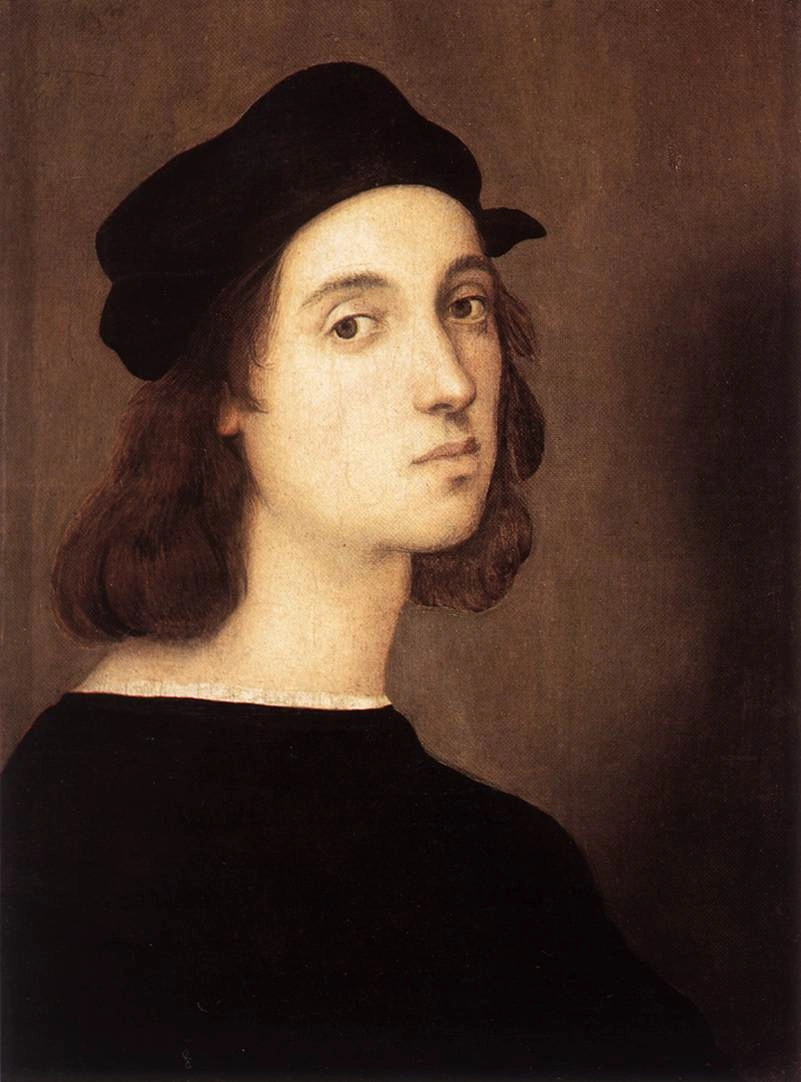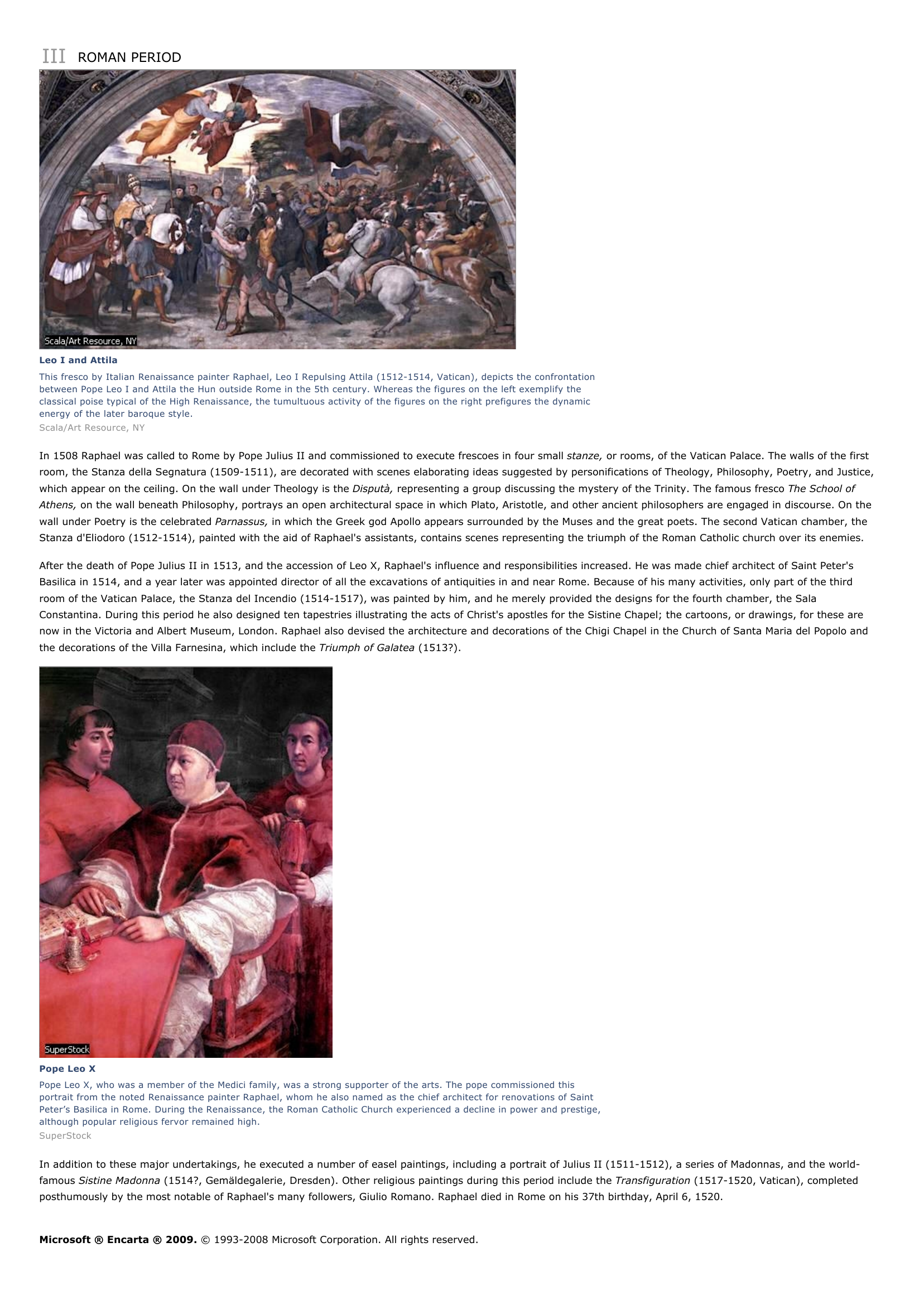Raphael (painter) I INTRODUCTION Raphael's La Belle Jardinière Completed in 1508 in Florence, La Belle Jardinière is one of the most famous Madonna portraits of Italian Renaissance painter Raphael.
Publié le 12/05/2013

Extrait du document


«
III ROMAN PERIOD
Leo I and AttilaThis fresco by Italian Renaissance painter Raphael, Leo I Repulsing Attila (1512-1514, Vatican), depicts the confrontationbetween Pope Leo I and Attila the Hun outside Rome in the 5th century.
Whereas the figures on the left exemplify theclassical poise typical of the High Renaissance, the tumultuous activity of the figures on the right prefigures the dynamicenergy of the later baroque style.Scala/Art Resource, NY
In 1508 Raphael was called to Rome by Pope Julius II and commissioned to execute frescoes in four small stanze, or rooms, of the Vatican Palace.
The walls of the first room, the Stanza della Segnatura (1509-1511), are decorated with scenes elaborating ideas suggested by personifications of Theology, Philosophy, Poetry, and Justice,which appear on the ceiling.
On the wall under Theology is the Disputà, representing a group discussing the mystery of the Trinity.
The famous fresco The School of Athens, on the wall beneath Philosophy, portrays an open architectural space in which Plato, Aristotle, and other ancient philosophers are engaged in discourse.
On the wall under Poetry is the celebrated Parnassus, in which the Greek god Apollo appears surrounded by the Muses and the great poets.
The second Vatican chamber, the Stanza d'Eliodoro (1512-1514), painted with the aid of Raphael's assistants, contains scenes representing the triumph of the Roman Catholic church over its enemies.
After the death of Pope Julius II in 1513, and the accession of Leo X, Raphael's influence and responsibilities increased.
He was made chief architect of Saint Peter'sBasilica in 1514, and a year later was appointed director of all the excavations of antiquities in and near Rome.
Because of his many activities, only part of the thirdroom of the Vatican Palace, the Stanza del Incendio (1514-1517), was painted by him, and he merely provided the designs for the fourth chamber, the SalaConstantina.
During this period he also designed ten tapestries illustrating the acts of Christ's apostles for the Sistine Chapel; the cartoons, or drawings, for these arenow in the Victoria and Albert Museum, London.
Raphael also devised the architecture and decorations of the Chigi Chapel in the Church of Santa Maria del Popolo andthe decorations of the Villa Farnesina, which include the Triumph of Galatea (1513?).
Pope Leo XPope Leo X, who was a member of the Medici family, was a strong supporter of the arts.
The pope commissioned thisportrait from the noted Renaissance painter Raphael, whom he also named as the chief architect for renovations of SaintPeter’s Basilica in Rome.
During the Renaissance, the Roman Catholic Church experienced a decline in power and prestige,although popular religious fervor remained high.SuperStock
In addition to these major undertakings, he executed a number of easel paintings, including a portrait of Julius II (1511-1512), a series of Madonnas, and the world-famous Sistine Madonna (1514?, Gemäldegalerie, Dresden).
Other religious paintings during this period include the Transfiguration (1517-1520, Vatican), completed posthumously by the most notable of Raphael's many followers, Giulio Romano.
Raphael died in Rome on his 37th birthday, April 6, 1520.
Microsoft ® Encarta ® 2009. © 1993-2008 Microsoft Corporation.
All rights reserved..
»
↓↓↓ APERÇU DU DOCUMENT ↓↓↓
Liens utiles
- Frank Sinatra Frank Sinatra (1915-1998), Italian American singer and motion-picture actor, one of the most famous American entertainers of his generation.
- Wolfgang Amadeus Mozart I INTRODUCTION Wolfgang Amadeus Mozart Wolfgang Amadeus Mozart, an 18th-century Austrian classical composer and one of the most famous musicians of all time, came from a family of musicians that included his father and sister.
- American Gothic painting, why is this painting one of the most famous american painting?
- Jason (Iason) Greek The hero of one of the most famous Greek legends, often known as "Jason and the Golden Fleece," or "Jason and the Argonauts.
- Comedy I INTRODUCTION Laurel and Hardy Stan Laurel, in overalls, and Oliver Hardy, left, formed one of the most popular comedy teams in motion-picture history.












